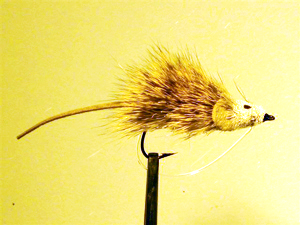United Fly Tyers of Rhode Island, Inc.
Rat Mouse
Tied by John O'Meara
Hook: 37187 stinger bass hook, size 6.
Thread: Gudebrod GX2 or any gel spun polyester, black flat waxed nylon for the head and nose.
Weed Guard: 20 lb, 0.022”dia, Mason’s hard monofilament. 3” long.
Tail: Ultrasuede 2” long
Ears: Ultrasuede, 1” wide, x 5/16” (or 3/8”) diameter dumbbell shaped.
Body: Natural deer body hair. (See note regarding hair).
Whiskers: Moose body hair.
Eyes: Black magic marker.
(Note on hair) We want the belly of this fly to flare, and the top not to flare. The heavier hair on the belly is what will allow this fly to float, and the fine hair on the top will not flare, but lay back as the natural. You could use two different patches, or as in our case, we will use the bottom half of the hair for the belly, and the tops of other bunches for the top of the body. (The bottom half of any strand of deerhair is the part that has the air pockets, and makes the best spinning or stacking hair. The top half lacks these air pockets, and therefore will not flare well.)
Directions
Step 1. Tie on just behind the hook eye, and wind back to the mid point of the bend. Wind quickly back to just over the point of the hook. At this point it’s a good idea to apply a coat of “zap-a-gap” to the entire thread base. Using the pinch technique, tie on the 3” piece of hard mono, and wrap it back to the mid point of the bend. Wrap quickly back to the point just over the barb. (See photo 107)
Step 2. Tie on the tail just over the barb. Cut very close to the skin a clump of hair, at least ¼” in diameter. Tie the butt ends on under the hook in the gape area. Next, remove half as much hair for the top, and tie it on top by wrapping throught the mid point of this clump toward the rear of the bottom clump. As you tighten the thread, hold it so it doesn’t spin around the hook. Keep it on the top.


